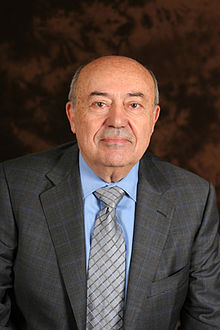Andrew J. Viterbi
| Andrew J. Viterbi | |
|---|---|
 |
|
| Born |
Andrea Giacomo Viterbi March 9, 1935 Bergamo, Italy |
| Citizenship | Italian, American |
| Education |
Massachusetts Institute of Technology (BS, MS) University of Southern California (PhD) |
| Spouse(s) | Erna Finci (m. 1958) |
| Children | Alexander Viterbi (1971–2011) Audrey Viterbi Alan Viterbi |
| Engineering career | |
| Discipline | Electrical |
| Institutions |
University of Southern California Board of Trustees The Scripps Research Institute Board of Trustees, Sanford Burnham Medical Research Institute |
| Employer(s) |
Professor: UC Los Angeles UC San Diego Founder/Co-founder: Linkabit Corporation Qualcomm Inc. The Viterbi Group |
| Projects | Viterbi algorithm |
| Significant advance | Code Division Multiple Access standard for cell phone networks |
| Awards | IEEE Alexander Graham Bell Medal (1984) Marconi Prize (1990) Claude E. Shannon Award (1991) National Medal of Science (2007) IEEE/RSE Wolfson James Clerk Maxwell Award IEEE Medal of Honor (2010) John Fritz Medal (2011) |
Andrew James Viterbi (born Andrea Giacomo Viterbi; March 9, 1935) is an American electrical engineer and businessman who co-founded Qualcomm Inc. and invented the Viterbi algorithm. He is currently Presidential Chair Professor of Electrical Engineering at the University of Southern California's Viterbi School of Engineering, which was named in his honor in 2004 in recognition of his $52 million gift.
Viterbi was born in Bergamo, Italy to Italian Jewish parents and emigrated with them in 1939 to the United States as a refugee because of the Italian racial laws. His original name was Andrea, but when he was naturalized in the US, his parents anglicized it to Andrew.
Viterbi attended the Boston Latin School, and then entered MIT in 1952, studying electrical engineering. He received both BS and MS in Electrical Engineering in 1957 from MIT.
He worked at Raytheon and later at Jet Propulsion Laboratory in Pasadena, where he started working on telemetry for guided missiles, also helping to develop the phase-locked loop. Simultaneously, he was carrying out a PhD study at the University of Southern California, where he graduated in 1963 in digital communications.
...
Wikipedia
